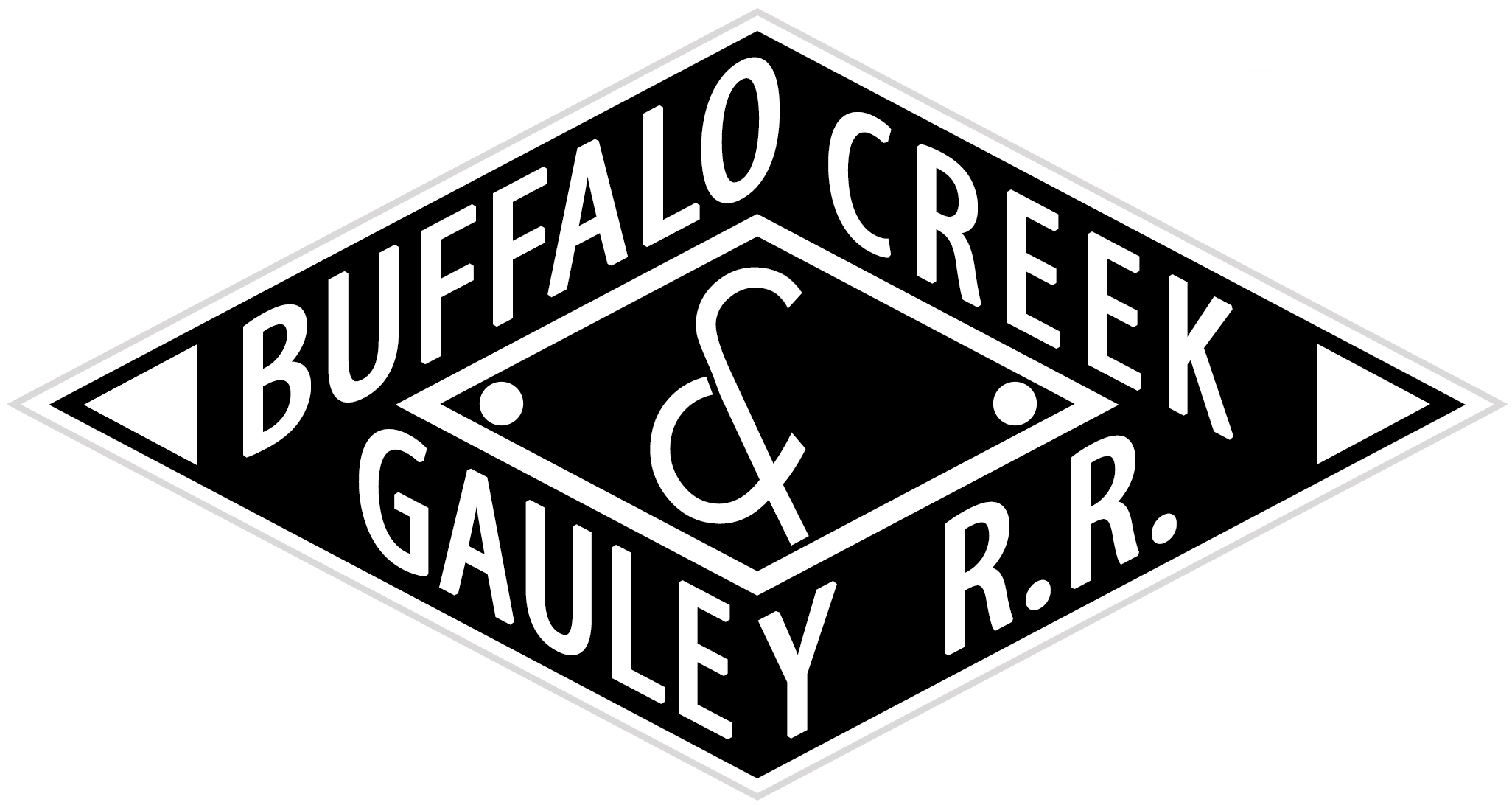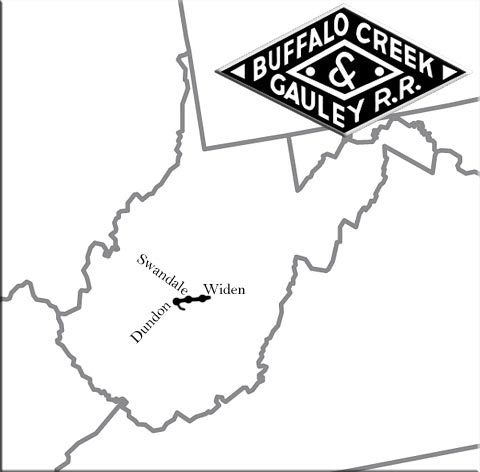Buffalo Creek & Gauley Railroad: Map, Roster, Logo, Photos
Last revised: August 22, 2024
By: Adam Burns
Positioned amidst the undulating hills and secluded hollows of West Virginia lay the Buffalo Creek and Gauley Railroad. With its modest length of just 19 miles, it may have been easy to overlook this short line railway. Yet despite its humble stature, it achieved the status of a legendary entity within the railroad industry.
The railway held the unique distinction of being the final sanctuary of the classic steam locomotive, still staunchly performing regular service in the U.S.
This best kept secret of the rail industry drew ardent rail enthusiasts and cultural historians alike. These aficionados gathered at the quaint hamlets of Dundon and Widen nestled in Clay County, drawn by the allure of witnessing the steadfast Consolidations in action. This enduring spirit of history and nostalgia is what made the BC&G so distinct and celebrated.
Unfortunately, when the coal mines and lumber business dried up in the 1960s, so did the railroad and the last regular scheduled freight train departed for the B&O interchange at Dundon on February 27, 1965.
While the railroad was revived twice during the 1970s and 1990s, it sat dormant and abandoned for years. In 2005 the Buffalo Creek and Gauley Railroad Co-Operative was formed to revive the entire railroad between Dundon and Widen as a tourist railroad.
However, these project also ultimately failed. The West Virginia State Rail Authority would later purchase the property in December, 2020 and as of the spring of 2024 efforts are underway to restore the railroad for railbiking via Rail Explorers.
Photos
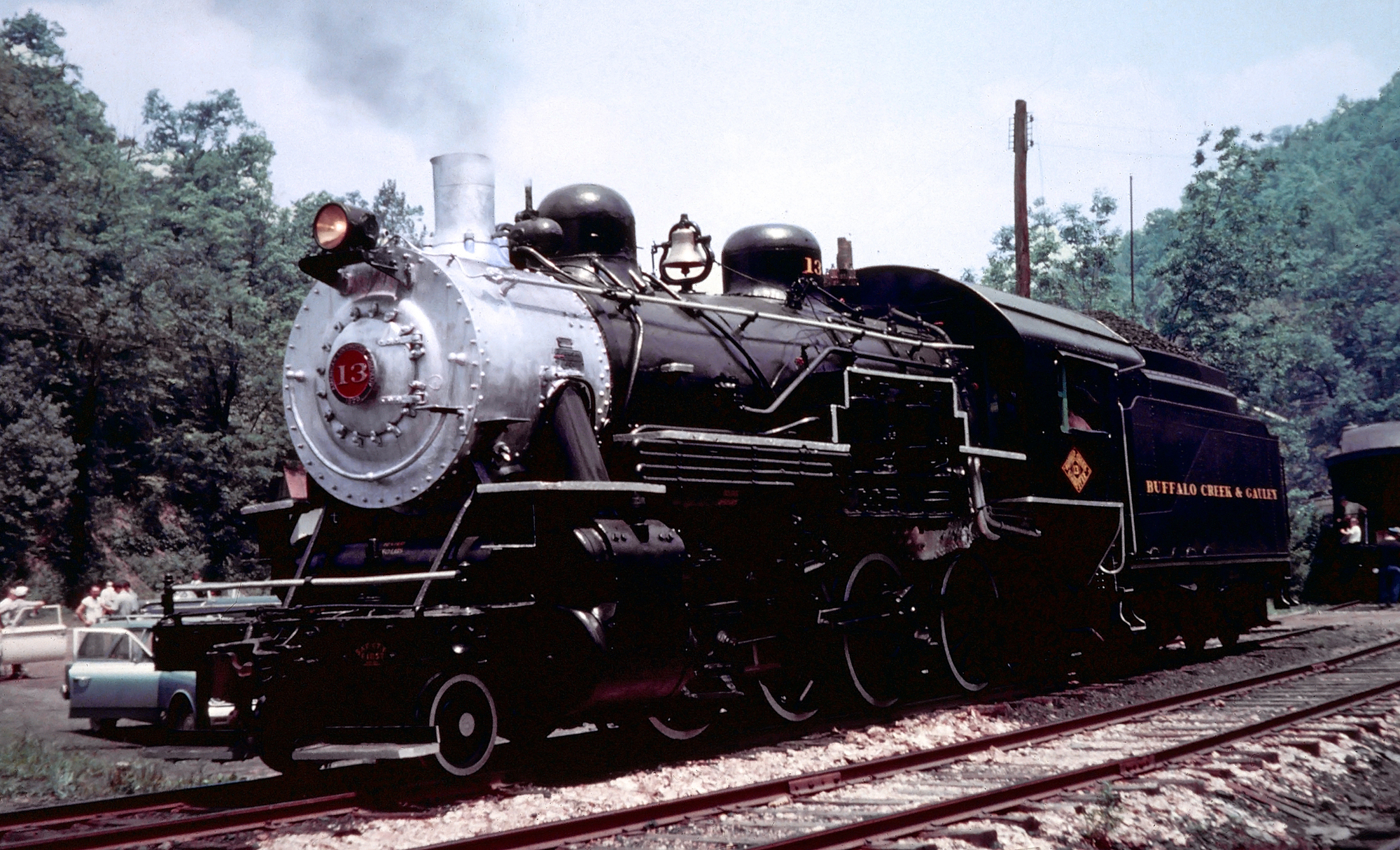 Buffalo Creek & Gauley 2-8-0 #13 is photographed here between excursion runs at Widen, West Virginia, circa 1963. Fred Byerly photo. American-Rails.com collection.
Buffalo Creek & Gauley 2-8-0 #13 is photographed here between excursion runs at Widen, West Virginia, circa 1963. Fred Byerly photo. American-Rails.com collection.History
It was in 1904 that the Elk River Coal & Lumber Company, brought to life under the visionary leadership of Joseph Garner Bradley, chartered the BC&G. Its inception was destined to transport the company's burgeoning coal and lumber interests within the region.
Initially, the railroad was conceived to be a significant venture, ambitiously extending over 100 miles to unite Dundon in Clay County with Huttonsville in Randolph County. However, these grand plans never came to fruition. Despite the high aspirations, railroad's reach was significantly curtailed, stretching a mere 18 miles from Dundon to Widen in the east.
At A Glance
Dundon - Swandale - Widen, West Virginia (Main Line) Dundon - Lily Fork, West Virginia (Elk River Coal & Lumber Logging Branch: 9 miles) | |
Expansion
About seven years after the railroad was chartered it finished its farthest stretch eastward to Widen in 1911. That same year Rich Run Mine was opened giving the BC&G another source of freight.
Logo
In 1918 the sawmill at
Swandale, located about halfway between Dundon and Widen, opened. These
vast sawmill operations, along with the coal mine at Rich Run (near Widen), were the BC&G's primary source of traffic for much of its
existence.
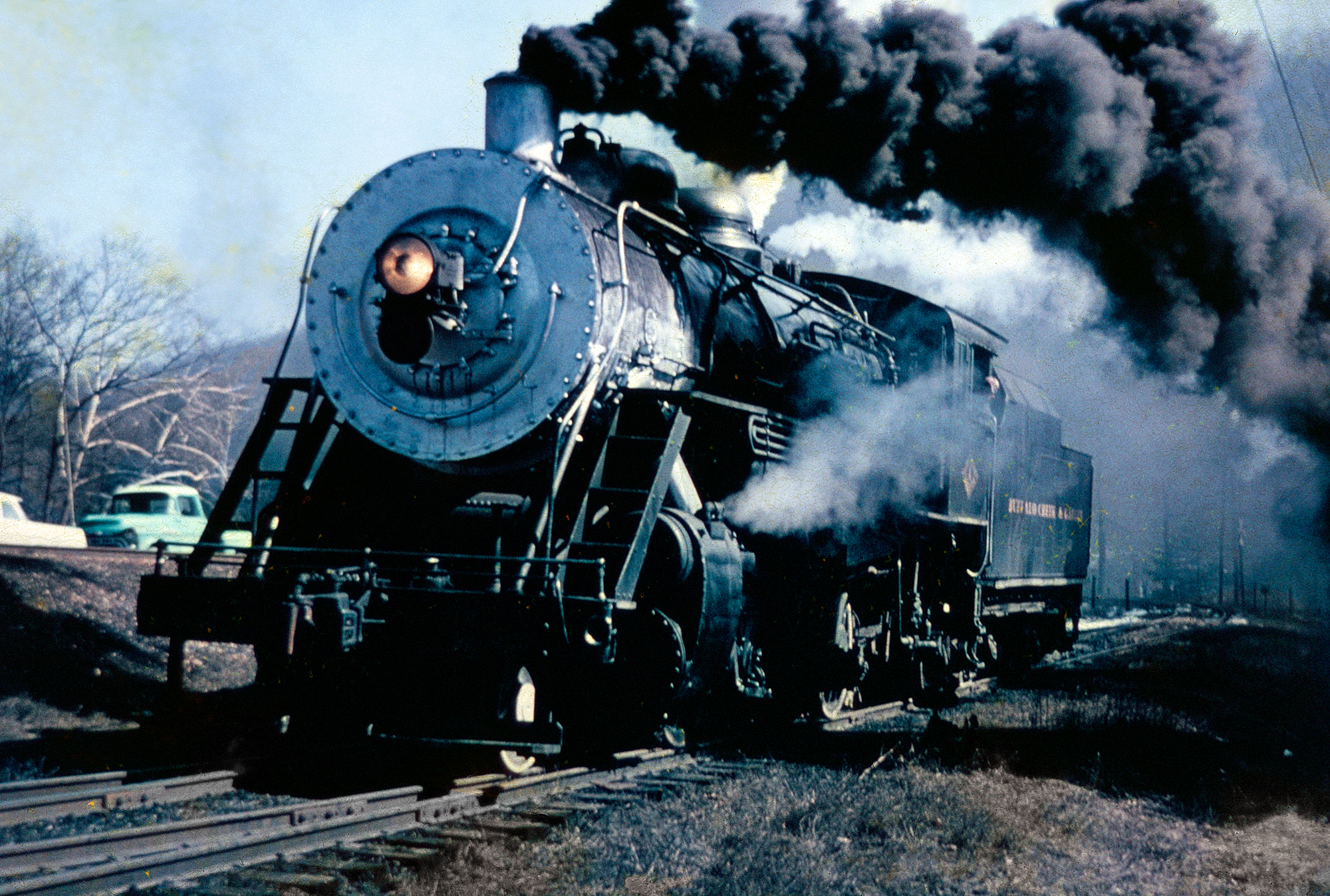 Buffalo Creek & Gauley 2-8-0 #4 steams up for railfans during a day of photo shoots and run-bys and the fall of 1964. Larry Fellure photo. American-Rails.com collection.
Buffalo Creek & Gauley 2-8-0 #4 steams up for railfans during a day of photo shoots and run-bys and the fall of 1964. Larry Fellure photo. American-Rails.com collection.Interestingly, of the BC&G's steam locomotives only four were ever purchased new, 2-8-0 Consolidation #4 from Baldwin Locomotive Works in 1926, and three Climaxes.
Of note, the BC&G did roster a few diesels including a Plymouth 44-Tonner, Whitcomb 65-Tonner, and even an Alco S1.
Locomotive Roster
Steam Locomotives
Climax (Two Truck), E-1 Through E-3: Purchased new.
Climax (Three Truck), E-4: Purchased second-hand.
4-4-0 American #1: Purchased second-hand from the Baltimore & Ohio Railroad.
2-8-0 Consolidation #2: Purchased second-hand from the Baltimore & Ohio Railroad.
2-8-0 Consolidation #3: Purchased second-hand from the Baltimore & Ohio Railroad.
2-8-0 Consolidation #4: Purchased new from Baldwin in 1926.
2-8-0 Consolidation #5: Purchased second-hand from the Chesapeake & Ohio Railway.
2-8-0 Consolidation #6: Purchased second-hand from the Baltimore & Ohio Railroad.
2-8-0 Consolidation #7: Purchased second-hand from the Baltimore & Ohio Railroad.
0-6-0 Switcher #8: The smallest engine ever rostered by the BC&G, it was acquired in 1945 and retired just five years later in 1950.
2-8-2 Mikado #9: Purchased second-hand from the Kelley's Creek & Northwestern Railroad.
2-8-2 Mikado #10: Purchased second-hand.
2-8-2 Mikado #11: Purchased second-hand.
Shay (Three-Truck) #12: Purchased second-hand.
2-8-0 Consolidation #13: Purchased second-hand from the Kelley's Creek & Northwestern Railroad.
2-8-0 Consolidation #14: Purchased second-hand from the Kelley's Creek & Northwestern Railroad.
2-8-2 Mikado #15-#17: Purchased second-hand.
Shay (Three-Truck) #18-#19: Purchased second-hand.
Diesel Locomotives
Alco S1 #1: Purchased second-hand.
Plymouth 44-Tonner #20: Purchased second-hand.
Whitcomb 65-Tonner #20: Purchased second-hand.
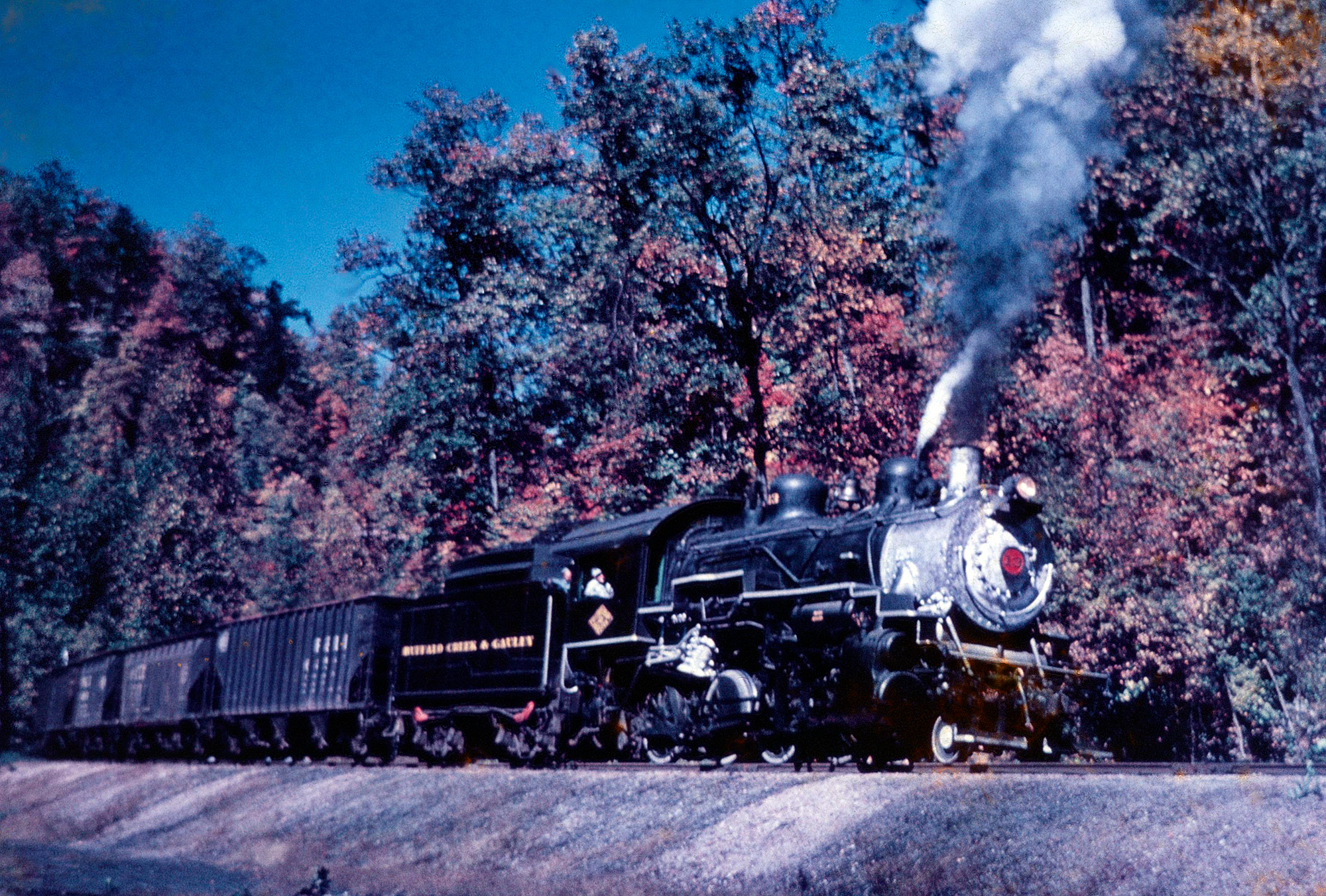 Buffalo Creek & Gauley 2-8-0 #13 pulls hoppers on the main line at Dundon, West Virginia in the fall of 1964. Larry Fellure photo. American-Rails.com collection.
Buffalo Creek & Gauley 2-8-0 #13 pulls hoppers on the main line at Dundon, West Virginia in the fall of 1964. Larry Fellure photo. American-Rails.com collection.However, their fortunes took a downward turn; facing a mounting tide of financial losses, in 1958, the ERC&L, along with all its subsidiary operations such as the BC&G, were sold off to the Clinchfield Coal Company.
This latest steward of the BC&G subsequently sold the mill to W.M. Ritter Lumber, and, keeping the wheels of the railroad turning, leased its operations to the aforementioned lumber company.
Despite these changes, the railroad's fortunes did not improve. A significant setback occurred in 1963 when the Rich Run Mine ceased operations.
A mere two years later, the final procession of finished lumber products exited Swandale, its destination being the B&O interchange at Dundon. Yet, the intriguing facet of the BC&G's history is that despite these events, they did not signify the end of its journey, but rather another twist in its captivating narrative.
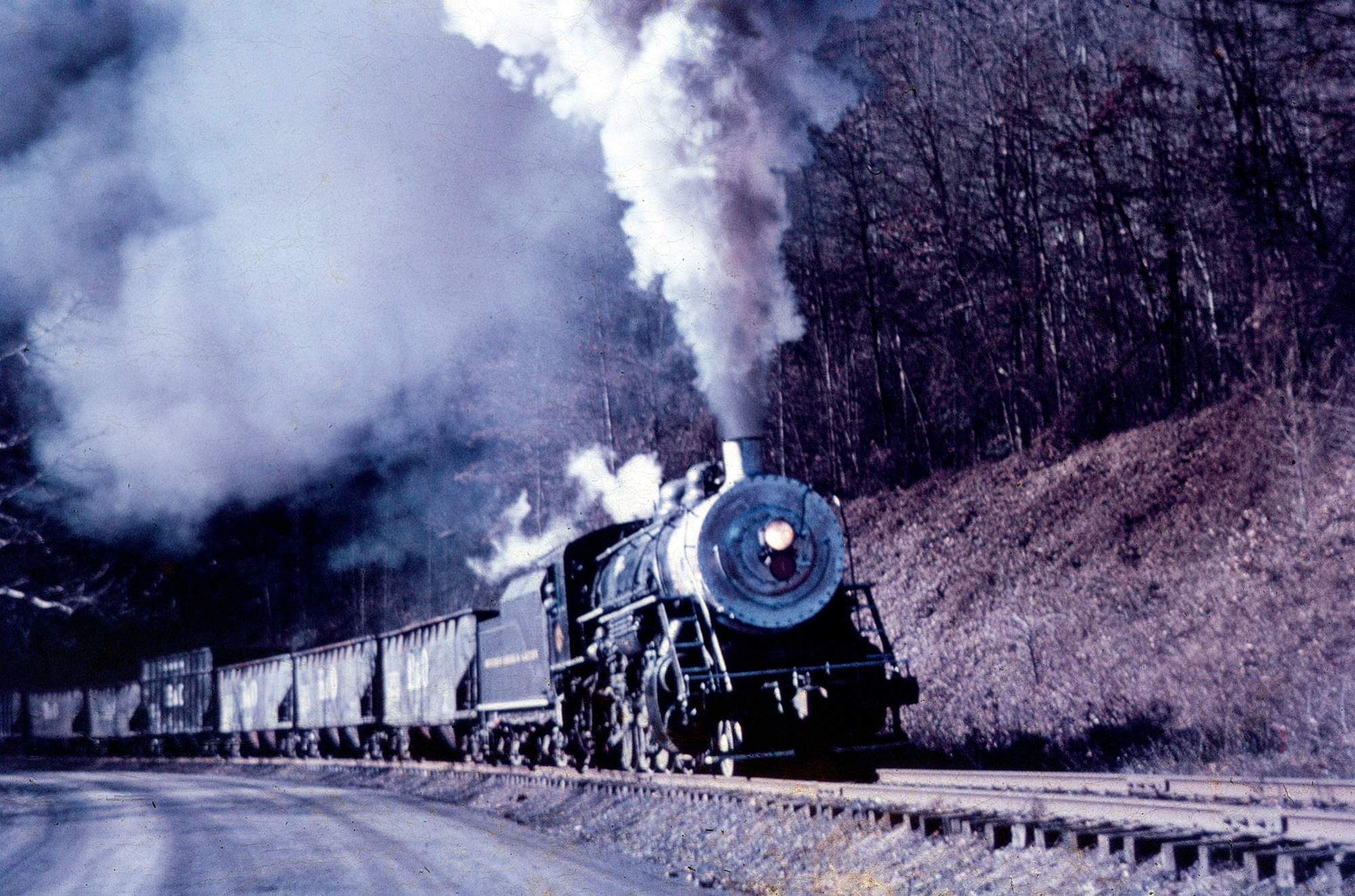 Buffalo Creek & Gauley 2-8-0 #4 pulls a cut of empty hoppers, and even an empty woodchip car, uphill west of Swandale, West Virginia in the fall of 1964. Larry Fellure photo. American-Rails.com collection.
Buffalo Creek & Gauley 2-8-0 #4 pulls a cut of empty hoppers, and even an empty woodchip car, uphill west of Swandale, West Virginia in the fall of 1964. Larry Fellure photo. American-Rails.com collection.In 1971 the railroad was revived by the Majestic Mining Company and reopened all of the way to Widen to serve a coal mine. It originally used a 65-ton Whitcomb (#20) for power and later an Alco S-2 (#2). The Majestic Mining operations lasted until 1985 at which the old railroad once again sat dormant.
System Map
 The Buffalo Creek & Gauley provided only a very minor listing in the Official Guide. This was the railroad's 1940 listing. Author's collection.
The Buffalo Creek & Gauley provided only a very minor listing in the Official Guide. This was the railroad's 1940 listing. Author's collection.But again fate saw a future for the BC&G and in the early 1990s the Elk River Railroad, Inc. was established to serve a mine at Avoca.
To reach the mine the Elk River Railroad purchased 61 miles of the B&O's former Elk River line between Gilmer and Hartland. The company had purchased the entire line to Widen but only refurbished the tracks to Avoca.
The coal loaded was
purchased by American Electric Power
(AEP) but nearly as soon as the railroad began operations it
all came to an end in the late summer of 1999 when AEP decided the coal
was substandard.
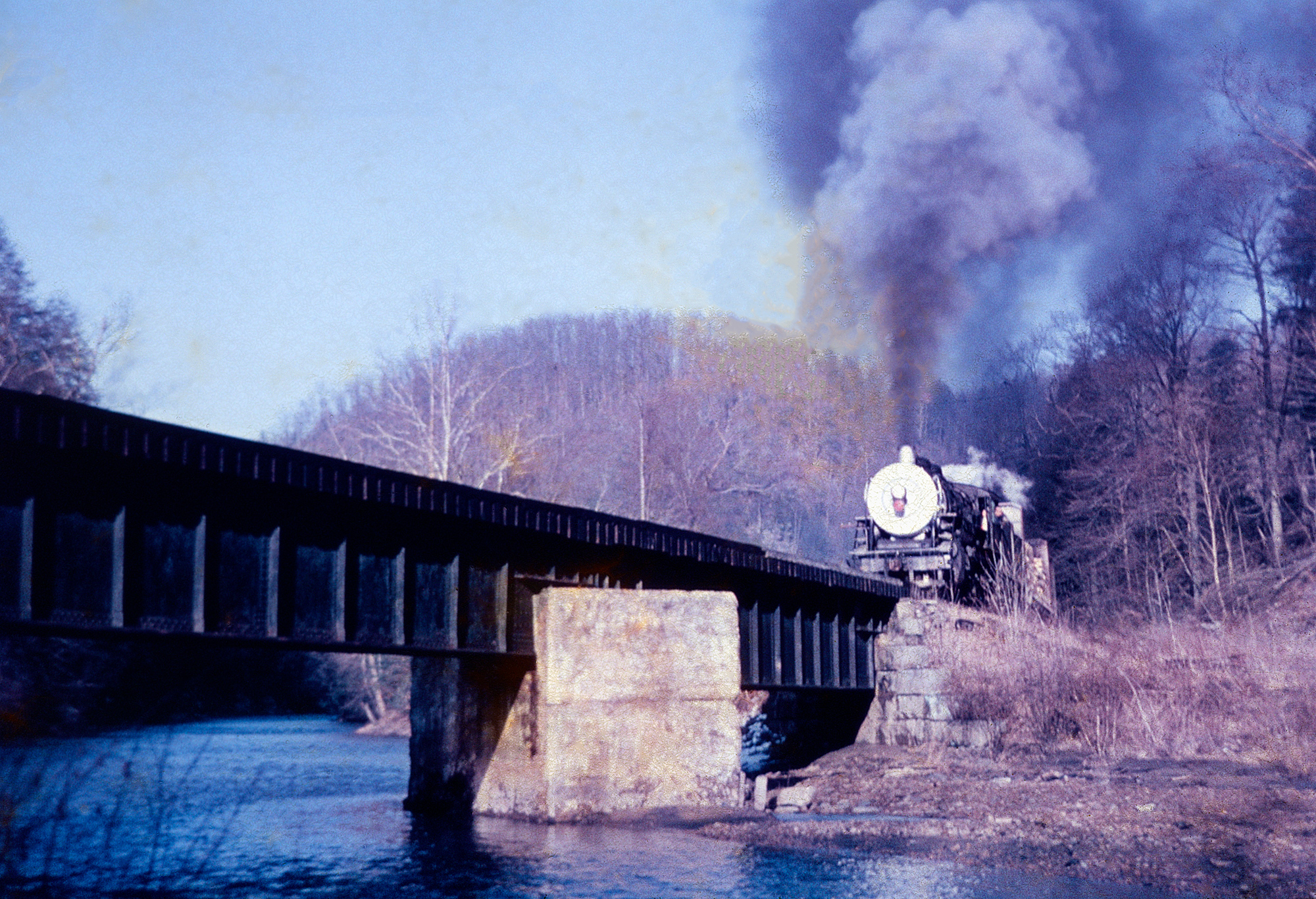 Buffalo Creek & Gauley 2-8-0 #4 is about to cross Sand Fork Trestle on a special photo run-by during the fall of 1964. Larry Fellure photo. American-Rails.com collection.
Buffalo Creek & Gauley 2-8-0 #4 is about to cross Sand Fork Trestle on a special photo run-by during the fall of 1964. Larry Fellure photo. American-Rails.com collection.Today
Over the years, the Elk River Railroad managed to stay afloat by generating modest revenue from the storage and refurbishment of CSX Transportation's rail cars at its Gassaway yard, which also housed its former offices.
Following the 1999 closure of the Avoca mine, speculation began to circulate regarding the possible resurrection of the Elk River's operations. This conjecture included visionary plans to rebuild the historic B&O route, extending all the way to Charleston. Such ambitious movements rippled a sense of anticipated excitement throughout the railway industry.
Sadly, not only did these promising ventures fail to materialize, but the 2010s also bore witness to the steady abandonment and removal of the esteemed Coal & Coke south of Gassaway. In a decisive move in March 2022, Elk River brought its operations to a halt, relegating its small ensemble of GP units to the care of the Durbin & Greenbrier Valley.
Despite this bleak narrative, there shines a beacon of hope for enthusiasts of the BC&G. Three of its steam locomotives have managed to stand the test of time, including the sterling 2-8-0 #4, originally purchased new. Currently, it is undergoing an extensive restoration at the Durbin & Greenbrier Valley since February, 2015, with plans to return it to service looming in the near future.
The locomotive, known by its nickname as "Old Slobberface" for its knack of leaking around its smokebox, has long been on display at the facility in Spencer and will be restored to operation by the D&GV.
It is slated to be returned to service and will likely operate on the former Western Maryland between Cass and Elkins.
Its sister steam locomotives, #13 and #14, also endure. #13 has found a home at the Age of Steam Roundhouse in Sugarcreek, Ohio, while #14 is cosmetically restored and on display at the Gaithersburg Community Museum in Gaithersburg, Maryland.
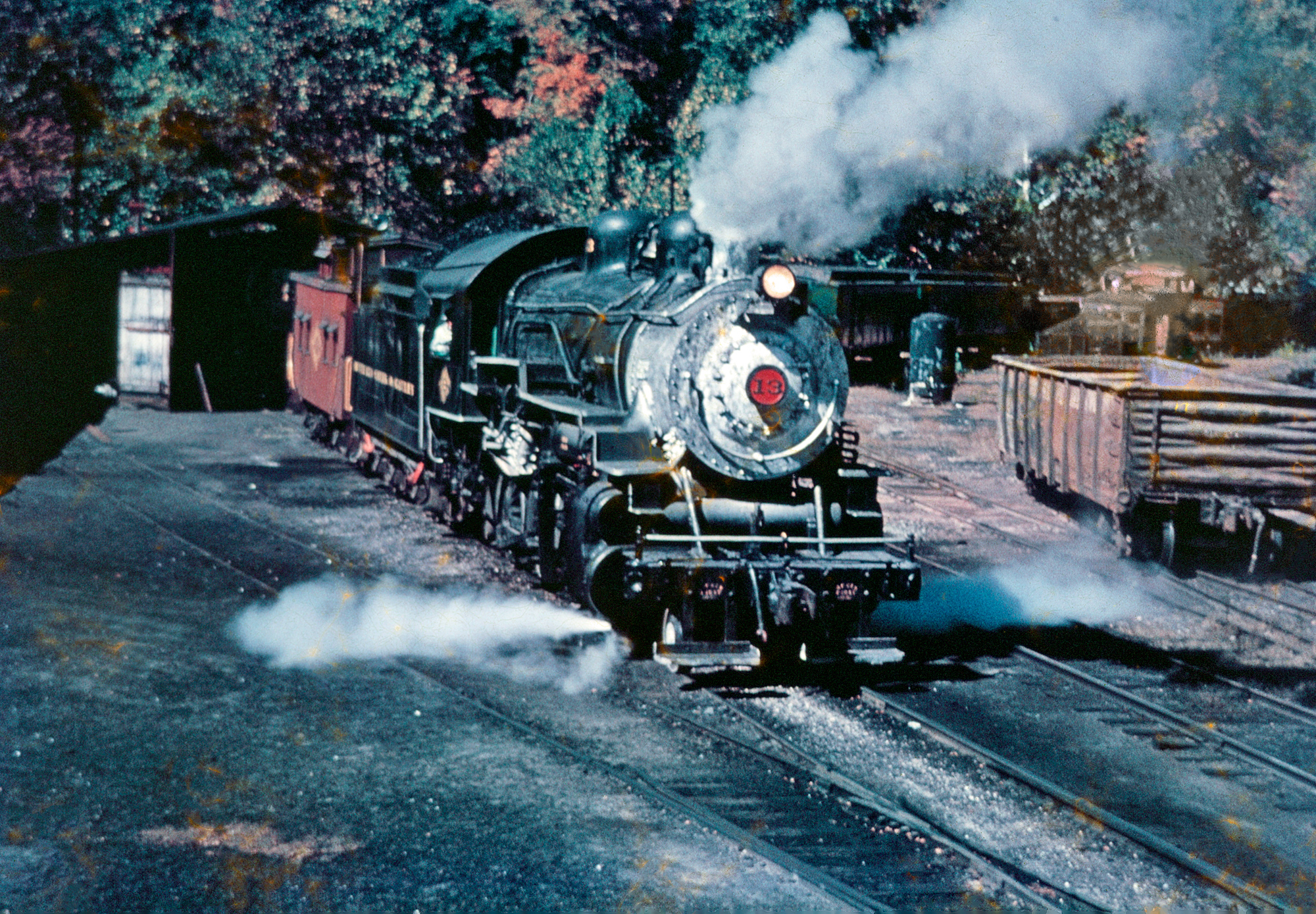 Buffalo Creek & Gauley 2-8-0 #4 clears out its cylinder cocks at the yard in Dundon, West Virginia during the fall of 1964. Larry Fellure photo. American-Rails.com collection.
Buffalo Creek & Gauley 2-8-0 #4 clears out its cylinder cocks at the yard in Dundon, West Virginia during the fall of 1964. Larry Fellure photo. American-Rails.com collection.In 2005 the BC&G again found a new life. That year the Buffalo Creek and Gauley Railroad Co-Operative was formed to refurbish the old railroad and operate a excursion train over the line.
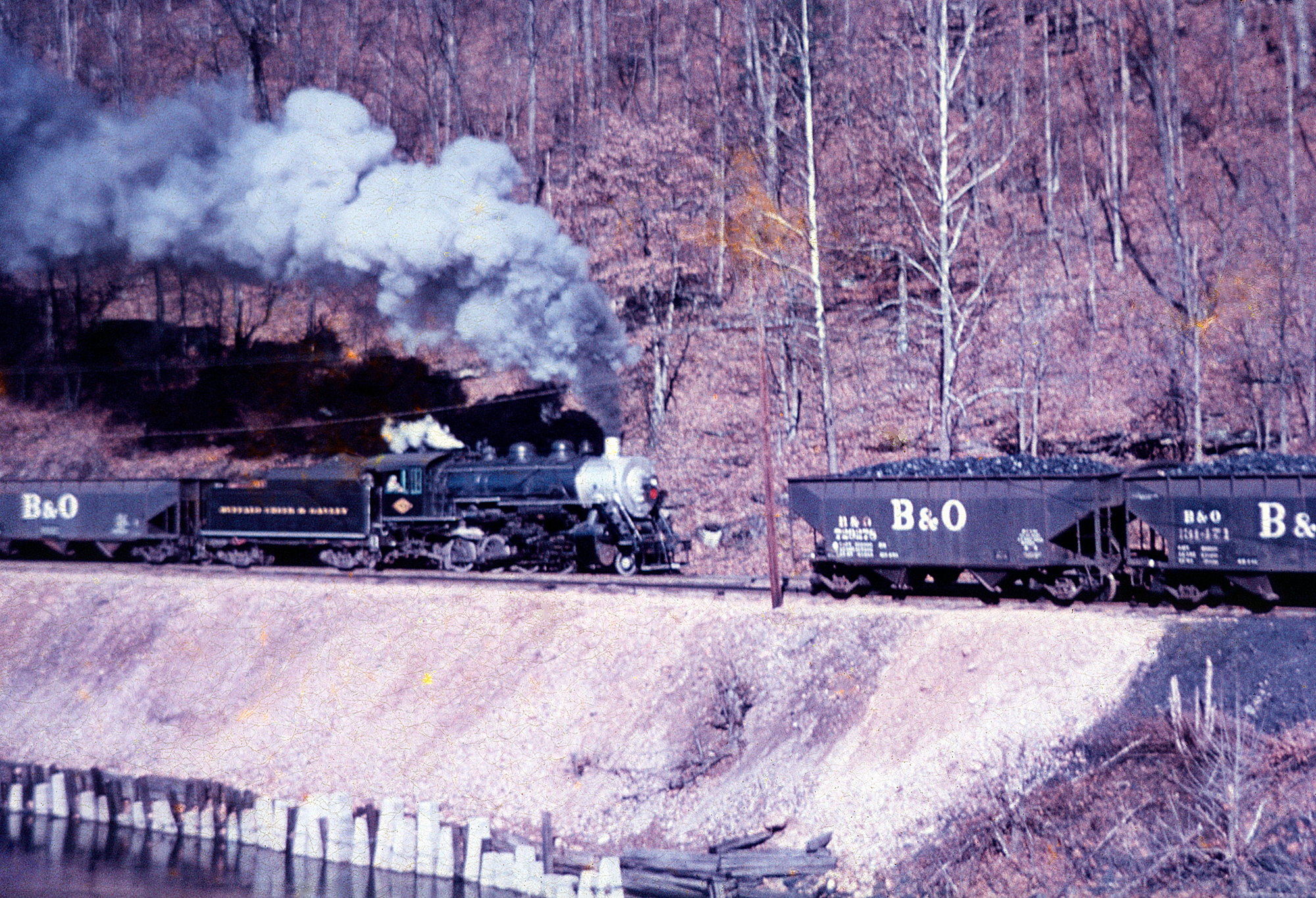 Buffalo Creek & Gauley 2-8-0 #4 pulls a cut of empties from the B&O interchange at Clay Junction, West Virginia during the fall of 1964. Larry Fellure photo. American-Rails.com collection.
Buffalo Creek & Gauley 2-8-0 #4 pulls a cut of empties from the B&O interchange at Clay Junction, West Virginia during the fall of 1964. Larry Fellure photo. American-Rails.com collection.Scenic Excursions
Under the organization's guidance the track was cleared and a new campground and lodge established on the site of the BC&G's old Dundon yard. Along with the campground and lodge the co-op was also able to acquire two cabooses for use in excursion service and a small GE 35-ton locomotive.
The dream was almost entirely self-funded from just a few volunteers although they were able to acquire a grant from the state of West Virginia to help in establishing the tourist line. Alas, however, the project stalled and quietly disappeared.
West Virginia stepped in and acquired the entirety of the old BC&G property in December, 2020. As of this writing the state currently only has plans to utilize the tracks for a railbiking operation.
It is interesting the state did not leave the connection in place to the BC&G at Dundon and acquire the old B&O's Coal & Coke Branch from that point to the Appalachian & Ohio connection at Gilmer.
Recent Articles
-
Oregon Railroad Museums: A Complete Guide
Apr 25, 25 03:11 PM
With its rich tapestry of scenic landscapes and profound historical significance, Oregon possesses several railroad museums that offer insights into the state’s transportation heritage. -
North Carolina Railroad Museums: A Complete Guide
Apr 25, 25 02:56 PM
Today, several museums in North Caorlina preserve its illustrious past, offering visitors a glimpse into the world of railroads with artifacts, model trains, and historic locomotives. -
New Jersey Railroad Museums: A Complete Guide
Apr 25, 25 11:48 AM
New Jersey offers a fascinating glimpse into its railroad legacy through its well-preserved museums found throughout the state.
